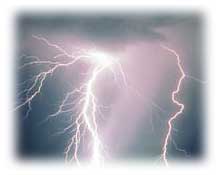

 Unlike a contained electric current passing
through a circuit, ESD is the sudden transfer or discharge of
electricity from one object to another. Most prevalent in dry,
low-humidity environments, it is caused by friction, which makes
objects become electrically charged or ionized. An electrical
charge builds up on the surface of an object, and the discharge
occurs because electricity seeks a path to ground.
Unlike a contained electric current passing
through a circuit, ESD is the sudden transfer or discharge of
electricity from one object to another. Most prevalent in dry,
low-humidity environments, it is caused by friction, which makes
objects become electrically charged or ionized. An electrical
charge builds up on the surface of an object, and the discharge
occurs because electricity seeks a path to ground.
Walking across a
carpet on a dry day,  then
being "zapped" when touching a doorknob is a familiar
example of electrostatic discharge.In this case, the person's
body is a conductor of electricity. There are two broad classes
of materials: conductors and insulators. A conductor passively
lets electrons flow through it easily. An insulator inhibits and
slows down the flow of electrons. Most non-metal objects are
insulators.
then
being "zapped" when touching a doorknob is a familiar
example of electrostatic discharge.In this case, the person's
body is a conductor of electricity. There are two broad classes
of materials: conductors and insulators. A conductor passively
lets electrons flow through it easily. An insulator inhibits and
slows down the flow of electrons. Most non-metal objects are
insulators.
Why does ESD pose a problem in manufacturing?
Wherever sensitive electronic components are handled, installed, or assembled, whether in cleanrooms or on factory floors, ESD poses a threat to product quality. One of the properties of an electrostatic charge is it's ability to attract dust and make it stick to things. An electrostatic charge on surfaces can easily cause them to be quickly coated with whatever dust is in the area.
 ESD
also poses a threat because of the very hot spark that is caused
by an ESD event. Electronic components, such as integrated
circuits, contain extremely fine, complex networks of circuits,
switches and transistors through which electronic signals pass.
When these components are suddenly "zapped" by ESD
during handling, the electrostatic surge causes an overload that
rips through the ultra-fine network paths.
ESD
also poses a threat because of the very hot spark that is caused
by an ESD event. Electronic components, such as integrated
circuits, contain extremely fine, complex networks of circuits,
switches and transistors through which electronic signals pass.
When these components are suddenly "zapped" by ESD
during handling, the electrostatic surge causes an overload that
rips through the ultra-fine network paths.
How is ESD controlled?
Factories are equipped with conductive floors that will not generate a charge. Employees wear special coats, and/or grounding straps on their shoes. When they are at a work bench, employees wear a grounding cord from their wrist to ground their bodies. Various types of ionizers are used to produce a gentle flow of ionized air to neutralize electrostatic charges on all kinds of materials. Millions of dollars are spent each year to battle ESD, but the potential for loss due to ESD caused damage is in the billions.
How does reducing ESD apply to data collection?
Increasingly, market standards such as those in the European Union, and regulatory compliance standards established by individual countries, require companies to engage in documented "cradle-to-grave" product tracking and enterprise-wide resource planning. Companies that can track component and sub-assembly to specific lot and vendor sources are better able to anticipate and handle potential product recalls, and thus reduce liability.
All-phase production tracking is a data collection function that allows company-wide utilization of data trends. As part of the tracking process, handheld scanners are increasingly being asked to meet rigorous ESD standards that ensure performance of the instrument and prevent damage to products being scanned.
Additional ESD Information on the World Wide Web